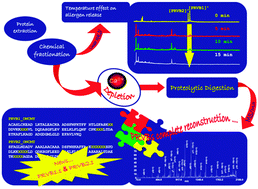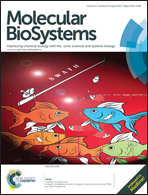A major allergen in rainbow trout (Oncorhynchus mykiss): complete sequences of parvalbumin by MALDI tandem mass spectrometry†
Abstract
Fish parvalbumin (PRVB) is an abundant and stable protein in fish meat. The variation in cross-reactivity among individuals is well known and explained by a broad repertoire of molecular forms and differences between IgE-binding epitopes in fish species. PVRB has “sequential” epitopes, which retain their IgE-binding capacity and allergenicity also after heating and digestion using proteolytic enzymes. From the allergonomics perspective, PRVB is still a challenging target due to its multiple isoforms present at different degrees of distribution. Little information is available in the databases about PVRBs from Oncorhynchus mykiss. At present, only two validated, incomplete isoforms of this species are included in the protein databases: parvalbumin beta 1 (P86431) and parvalbumin beta 2 (P86432). A simple and rapid protocol has been developed for selective solubilization of PRVB from the muscle of farmed rainbow trout (Oncorhynchus mykiss), followed by calcium depletion, proteolytic digestion, MALDI MS, and MS/MS analysis. With this strategy thermal allergen release was assessed and PRVB1 (P86431), PRVB1.1, PRVB2 (P86432) and PRVB2.1 variants from the rainbow trout were sequenced. The correct ordering of peptide sequences was aided by mapping the overlapping enzymatic digests. The deduced peptide sequences were arranged and the theoretical molecular masses (Mr) of the resulting sequences were calculated. Experimental masses (Mr) of each PRVB variant were measured by linear MALDI-TOF.


 Please wait while we load your content...
Please wait while we load your content...